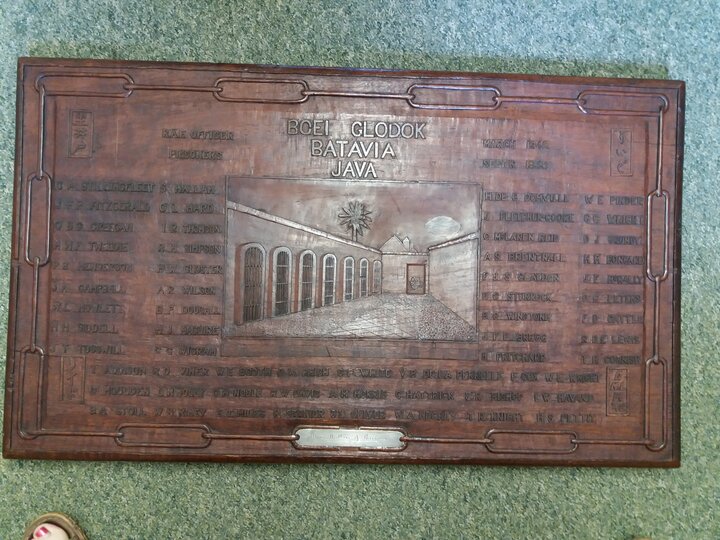Carved table top

One of the older RAF officers, Claude McLaren Reid was born in Scotland at the beginning of the 20th century. He was brought up in Argentina and later became a pre-war resident of Sydney, Australia. Before capture in Java in March 1942, Reid worked in Malaya as a customs officer. Remaining of the island for the duration, Reid was part of a large group of RAF men held early on at Boie Glodok gaol in Batavia, the capital of Java. Needing a table, he acquired a large teak panel measuring 34” by 20” for the tabletop. Before long it was to provide a different purpose.
The Japanese commander of the camp at that time encouraged arts and crafts, and an exhibition of items captured Reid’s imagination. He decided to do something with his tabletop, first writing on to the wood the names of all 60 RAF officers and warrant officers held in the gaol with him. Then with a blunt gouge, he removed the wood from around the three blocks of names before painstakingly carving out the letters of each name with a penknife. The names stood proud in three blocks, either side and below a central space into which he carved a depiction of the gaol’s solitary confinement cells which faced an open courtyard.
In three of the four corners of the carving, the small oblong boxes contain his name “Reid-o” in three different forms of Japanese characters; bottom right are the artist’s initials followed by the year, ‘42. The whole thing was surrounded by a symbolic chain, modelled from the shackles worn by the civilian occupants in the gaol. It took four months during that first summer of captivity to create the carving.
The carved chain link was modelled on that used on the civilian inmates of the gaol. The centre bottom link however was made one inch larger than the rest in preparation for the day of liberation would one day dawn. He describes how, once reunited with the table top in December 1946, he cut that link to denote their freedom. Into the broken link he would later insert an inscribed, engraved silver plate. The silver plate came from the melted fork and spook he had kept and used throughout captivity which a local silversmith created for him. He sent the small silver plate to Lord Mountbatten explaining the purpose and asking if he would sign it (Figure 28). This was returned, duly signed, and Reid had the signature engraved and the silver set into the broken link.
Reid coated the tabletop with brown boot polish and made a plywood cover for the top to protect it. Then without warning the RAF men were being transferred to Tandjong Priok transit camp on the docks north of Batavia and so he gave it to a Dutch officer in Boie Glodok to take care of. Reid was not to see the table top again during captivity.
In 1947, when back working as a Custom’s Officer in Kuala Lumpur, Reid wrote The Tale of a Table. The table top, like its creator, survived the following three years of captivity and his booklet details what happened to it after Reid was drafted from Java and it was left in the care of a Dutch officer and friend, Lieutenant G. Vischer who remained in the gaol briefly. At the end of his booklet, Reid makes this tribute: “To the relatives of those who have gone, I offer it as my humble tribute to the memory of the dead”.
His table top is a tour de force.
Click here to read the Tale of a Table by Claude McLaren Reid
Abridged by Meg Parkes from Captive Artists, Unseen Artwork by British Far East Prisoners of War.
The table top features in the exhibition: Secret Art of Survival, Creativity and Ingenuity of Far East prisoners of war, 1942-1945 at the Victoria Gallery & Museum in Liverpool (October 2019 to June 2020).
Loaned by COFEPOW archives, with kind permission of the Booth family.
RAF Officer Prisoners of War, Boie Glodok Gaol, Batavia March 1942
Names carved into the teak table top made by Fl/Lt C. M. Reid
Left hand column:
Stillingfleet, G. A. G. A. Hallam, S.
Fitzgerald, J. F. P. J. F. P. Hard, C. L.
Creegan, O. D. G. O. D. G. Thomson, I. R.
Tweedie, M. W. F. M. W. F. Simpson, R. H
Henderson P. R. P. R. Closter, H.W.
Campbell, J. A. J. A. Wilson A. R.
Howlett W. L. W. L. Dougall, B. P.
Siddell, H. H. H. H. Maguire, H. J.
Tosswill, J. T. J. T. Wigram, C. C.
Right hand column:
Domville, H. de C. Pinder, W. E.
Fletcher-Cooke, J. Wright, G. C.
McLaren Reid, C. Grundy, D. J.
Brentnall, A. S. Bongard, H. M.
Clayden, F. J. S. McNally, J. F.
Sturrock, D. C. Peters, D. C.
Winstone, B. C. Cattle, F. B.
Gregg, J. F. F. Lewis, R. D. E.
Pritchard, H. Cornish, T. M.
Across the bottom:
Top Line: Addison, J., Viner, R.D., Booth, W. E., Reich, D. A., White, G. P., Perrelle, V. B. de la. Cox, F., Wright, W. E.
Middle Line: Moulden, D., Jolly, L. H., Noble, C. H., Davis, R. W., Morris, A. M., Hattrick, C., Bishop E. R., Havard, I. W.
Bottom line: Stoll, B. A., Riley, W. N., Miles, E. T., Stonier, R., Oliver G. L., Hockey, W. A., Knight, T. R., Pettit, H. S.
